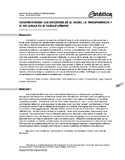| dc.rights.license | http://creativecommons.org/licenses/by-nc-sa/3.0/ve/ | |
| dc.contributor.author | Yánez, Edgar | |
| dc.date.accessioned | 2009-07-28T22:46:51Z | |
| dc.date.available | 2009-07-28T22:46:51Z | |
| dc.date.issued | 2009-07-28T22:46:51Z | |
| dc.identifier.issn | Revs-0002 | es_VE |
| dc.identifier.uri | http://www.saber.ula.ve/handle/123456789/29061 | |
| dc.description.abstract | La tradición moderna ha ejercido notable influencia en la arquitectura contemporánea a través de la introducción de elementos basados en la eficiencia racionalista y una clara renuncia a la clásica relación arquitectura-arte, habiendo llegado a ser vista incluso como delito a ser evitado. Sentencias tales como “La forma sigue a la función” o “Menos es más”, han guiado por décadas la reflexión y respuesta arquitectónica. Aun hoy, la arquitectura mas “osada” entra en franca contradicción cuando al intentar vencer los paradigmas de la modernidad recurre a sus mismos métodos de análisis, proponiendo nuevas actitudes que generalmente descansan en logros formales que repiten, aunque de manera diferente, no pocos
de los errores de la modernidad. Términos como el vacío, la transparencia y los no lugares, han permanecido durante décadas en el discurso arquitectónico y urbano, sin que la modernidad ni la posmodernidad hayan estructurado un lenguaje que los incorporen como elementos que ayuden a definir el “sentido del espacio urbano” y por el contrario han sido considerados como meros accidentes formales. Contrariamente, el arte contemporáneo y la semiología han asumido ese papel en la difícil tarea de comprender la ciudad desde su fenomenológica, superando con creces el tradicional análisis morfológico con que suele ser estudiada la ciudad desde la arquitectura y el urbanismo. | es_VE |
| dc.language.iso | es | es_VE |
| dc.rights | info:eu-repo/semantics/openAccess | |
| dc.subject | Ciudad | es_VE |
| dc.subject | Modernidad | es_VE |
| dc.subject | Postmodernismo | es_VE |
| dc.subject | Vacío | es_VE |
| dc.subject | Transparencia | es_VE |
| dc.subject | Lugar | es_VE |
| dc.subject | Espacio urbano | es_VE |
| dc.subject | Semiótica | es_VE |
| dc.title | Confrontando las nociones de el vacío, la transparencia y el no lugar en el paisaje urbano | es_VE |
| dc.type | info:eu-repo/semantics/article | |
| dc.description.abstract1 | The modern tradition has had a remarkable influence on contemporary architecture throughout the introduction of elements based upon the efficient rationalism spirit and getting rid of the classic relationship architecture-art, in such a way that it has been considered as a crime that should be avoided. Statements such as “Form follows function” or “Less is more” have ruled the architectural reflections and responses for decades. Even now, the “bravest” architecture is in franc contradiction when it tries to defeat the paradigms of modernity but applies the same methods for analysis, while suggesting new attitudes that lay on formal outcomes that mirror - although in a different way - not few of the mistakes of modernity. Terms such as emptiness, transparency and no-places, have remained in the architectural glossary for decades, while neither modernity nor postmodernism have developed an architectural and urban language which incorporate them as elements that can
help to define the “sense of urban space”, instead of considering them just as formal accidents. In contrast, contemporary art and semiotics have played such a role and assumed the hard task of understanding the city from a phenomenological approach, beating the traditional morphological analysis through which the city is usually studied by architecture and urbanism. | es_VE |
| dc.description.colacion | 157-171 | es_VE |
| dc.description.email | andurill022@yahoo.com.mx | es_VE |
| dc.description.frecuencia | semestral | es_VE |
| dc.identifier.depositolegal | 199702ME179 | es_VE |
| dc.subject.centroinvestigacion | Centro de Investigaciones Estéticas (CIE) | es_VE |
| dc.subject.facultad | Facultad de Humanidades y Educación | es_VE |
| dc.subject.keywords | City | es_VE |
| dc.subject.keywords | Modernity | es_VE |
| dc.subject.keywords | Postmodernity | es_VE |
| dc.subject.keywords | Emptiness | es_VE |
| dc.subject.keywords | Transparency | es_VE |
| dc.subject.keywords | Place | es_VE |
| dc.subject.keywords | Urban Space | es_VE |
| dc.subject.keywords | Semiotics | es_VE |
| dc.subject.publicacionelectronica | Revista Estética | es_VE |
| dc.subject.thematiccategory | Artes y Humanidades | es_VE |
| dc.subject.tipo | Revistas | es_VE |
| dc.type.media | Texto | es_VE |



